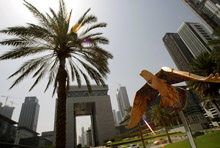
Typical street scene in Santa Ana, El Salvador. (Photo: iStock)
IMF Survey: New IMF Study Offers Options for Bolstering Gulf Economies
October 17, 2011
- Generating jobs for nationals is an important priority
- Fiscal policy is key for maximizing the benefits of natural resource wealth
- Region is closely interconnected with the global economy
Strong growth in the Gulf Cooperation Council (GCC) countries over the past decade has not delivered all the expected results, particularly with respect to generating jobs for the region’s nationals and reducing dependence on oil and gas revenues, the IMF says.

Dubai skyline: A new IMF study discusses how to generate jobs and other economic policy issues facing the Gulf region (photo: AFP/Karim Sahib)
MIDDLE EAST
According to a new study published by the IMF’s Middle East and Central Asia Department, the resource-rich countries of the GCC face unique challenges. The region’s economies are dominated by the highly capital-intensive oil and gas sector and will continue to be for the foreseeable future. Despite accounting for almost half of GDP, however, the oil sector employs less than 3 percent of the region’s labor force. As a result, a large part of the region’s growth has had a limited impact on employment.
How to generate jobs for the fast-growing populations in the GCC countries is one of several policy issues discussed in Gulf Cooperation Council Countries: Enhancing Economic Outcomes in an Uncertain Global Economy. Produced by a staff team led by IMF economists Samya Beidas-Strom, Tobias Rasmussen, and David O. Robinson, the report also presents analytical work exploring how best to enhance the effectiveness of fiscal and monetary policies, reduce vulnerabilities, and use the region’s oil wealth to ensure that future generations may also benefit.
“The study shows how interlinked the GCC’s economies are with the global economy,” the IMF team noted. “Not just through the price of oil, but also through the role of expatriate labor, via global financial markets, and the impact of fiscal and monetary policies in the advanced economies and emerging Asia.”
Growth strategies
The study begins by outlining the GCC countries’ national development strategies, which emphasize economic diversification and employment creation. Over the past decade, dependence on gas and oil revenues has increased as a result of higher oil prices, but all GCC countries have experienced growth in the non-oil economy, particularly in services. This growth has translated into a rapid increase in employment, but many of the jobs have gone to expatriates who now account for more than half of the total labor force (or significantly more, in some countries).
Consequently, unemployment among GCC nationals is a concern in many GCC countries, and with more than 4 million new nationals expected to enter the job market over the next five years, the problem could worsen.
To meet the region’s development objectives, a reorientation of the growth model—not merely an acceleration of growth—will be key. Such a growth model should strive to improve productivity, foster the emergence of the private sector, and ensure that labor market policies support the employment of nationals, the report says.
GDP and welfare
The second chapter explores the issue of identifying an appropriate measure of welfare in the GCC. GDP is commonly used to gauge economic progress because it is readily available and tends to be closely correlated with other indicators of welfare, such as health and education.
Because of the dominant role of the oil sector and the preponderance of expatriate labor in these countries, however, GDP may not be the best measure of welfare, as it is only weakly linked to variables such as employment and consumption that are central to economic well-being.
Instead, the authors suggest, policymakers would be better served by looking at other indicators. For gauging progress in employment creation, it would be useful to look at the number of jobs created, in which sectors, and at what qualifications. For determining progress in living standards, it would be desirable to look at the volume, type, and composition of consumption.
Fiscal policy
The third chapter examines the role of fiscal policy in maximizing the social and economic outcomes from the region’s natural resource revenues.
The report notes that fiscal policy is the key policy instrument in GCC countries, playing three main roles: a stabilization role to smooth the impact of economic fluctuations caused by oil price movements and other shocks through the timing of taxation and spending decisions; a developmental role to improve the welfare of the region’s nationals through infrastructure, education, and other expenditures; and a role in preserving the wealth for future generations.
These various roles of fiscal policy sometimes result in differing—and potentially conflicting—policy decisions. The report discusses how the GCC can best design policies to balance these different objectives.
Monetary policy
With all GCC exchange rates (apart from Kuwait) pegged to the U.S. dollar and relatively open capital accounts, monetary policy in GCC countries would be expected to move closely in line with the U.S. The report’s fourth chapter confirms that GCC policy rates move closely with U.S. interest rates in the long term, but that in the short term GCC authorities have used the tools available to them to influence domestic liquidity and credit conditions.
Spillovers
The report’s remaining chapters highlight additional linkages between the GCC and the rest of the world and how these evolved during the global financial crisis.
Chapter 5 looks at the evolution of credit default swap spreads in the GCC, and examines the region’s susceptibility to regional and global financial contagion. Chapter 6 explores the linkages between fiscal policy decisions in Saudi Arabia and the global economy as well as the potential impact on the Saudi economy of a growth slowdown in emerging Asia.
The final chapter, on corporate sector vulnerabilities, analyzes the evolution of the balance sheets of companies during and after the global financial crisis. It finds that the corporate sector has, on aggregate, built a large cash cushion that helps mitigate risks from future shocks.







